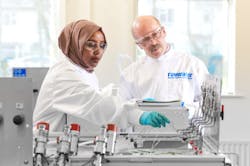Oilfield souring technology establishes parameters for souring potential
Only recently, Rawwater used its knowledge of oilfield souring to demonstrate to a leading operator that downhole conditions within one of its West African assets meant that a costly sulphate removal plant (SRP) would not be required. The resulting savings in plant and infrastructure were estimated to exceed $100 million. Crude from some oilfields is sweet, whereas from others it is sour. More expensive to refine, due to higher concentrations of highly corrosive sulphur (typically more than 5%), sour crude requires the use of corrosion-resistant topsides equipment, expensive sulphate removal technologies and chemical dosing regimes.
Microbiological reservoir souring
Geology and geochemistry aside, the process of pumping sulphate-containing water (typically seawater) into oil reservoirs — to maintain pressure during secondary recovery — can introduce sulphate-reducing bacteria into a sweet oil environment. Where conditions are right, the result is the production of hydrogen sulphide and a phenomenon known as microbiological reservoir souring. However, as it can take several years of microbial activity before higher levels of souring are noticed in output, the challenge is to identify the likelihood of souring early enough to establish cost-effective treatment strategies — particularly as reservoir souring is thought to take up as much as a third of production budgets.
Concerned that platforms originally set up for sweet oil production will be unsuitable for the receipt of sour crude, topsides operators may, understandably, choose to invest in costly SRPs for souring control where there is a risk of microbiological souring.
Leading the understanding of microbiological oilfield souring
For more than 30 years, Rawwater has been cultivating oilfield bacteria strains and operates an advanced facility for the study of microbiological oilfield souring under laboratory conditions.
Oilfield souring studies were once completed through the use of simple sand, oil and seawater bottle tests or "up-flow" sand packs subjected to atmospheric pressure. These tests, however, were unable to replicate the temperature and pressure conditions found downhole, meaning it was not possible to establish the effects of temperature and pressure on oilfield microbiology. By comparison, Rawwater operates a suite of more than 50 pressurized bioreactors constructed corrosion-resistant columns that are filled with sand, seawater and crude, inoculated with oilfield bacteria, and then subjected to the same pressures and temperatures as found in the reservoir environment. Testing pressures range from atmospheric pressure to 12,000 psig, with testing temperatures ranging from 5°C to just below the boiling point of water.
Predictive oilfield souring tool
To establish if, when, and to what level an oilfield will sour, data from Rawwater’s pressurized bioreactor studies is then entered into the organization’s DynamicTVS (Note: TVS = Thermal Viability Shell) predictive oilfield souring tool. Developed over many years, DynamicTVS can forecast a reservoir’s propensity to sour in good time for cost-effective remedial strategies to be put in place. By applying its DynamicTVS souring forecasting model to data from the West African asset, Rawwater showed the operator the pressure and temperature conditions found within the well were too extreme to support the microbiological growth that would lead to sulphide production. To corroborate the findings, a 12-month pressurized bioreactor study then took place.
Rawwater’s pressurized bioreactor program
Rawwater’s pressurized bioreactor research program began in 2006. The program was instrumental in the birth of the Seriatim series of work into oilfield souring, with $10 million in funding being set aside for Rawwater to establish a pressurized bioreactor dataset. By October 2018, 12 years after the program’s start date, Rawwater had built up no less than the equivalent of 400 years’ worth of oilfield souring data.DynamicTVS
Rawwater’s software modeling program, DynamicTVS, can forecast a reservoir’s propensity to sour in advance of well completion. The DynamicTVS model describes the cooling of an oil reservoir due to water flooding, the opportunity for growth of sulphate-reducing microorganisms (SRMs) in the cooled zone, the movement of resultant hydrogen sulphide to the producer and the downhole and topsides partitioning of the sulphide at specified pressures and temperatures. DynamicTVS was developed at UMIST. To date, more than 130 souring forecasts, including single injector/producer (I/P) pair forecasts and full-field statistical analysis, have been completed for clients worldwide.
